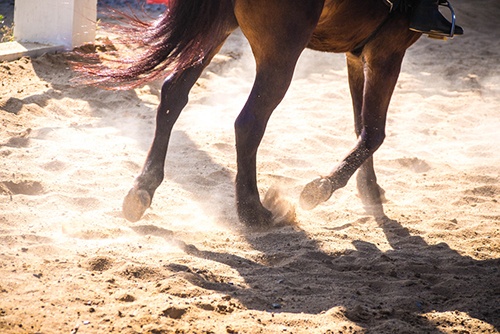Floyd Fain
March 14, 2017 When you consider what’s at stake when taking your horse into an arena – not just in terms of his performance but in terms of his comfort and safety – you can appreciate the difference that the arena footing makes.
When you consider what’s at stake when taking your horse into an arena – not just in terms of his performance but in terms of his comfort and safety – you can appreciate the difference that the arena footing makes.
It may look simple to identify and use, but footing goes much deeper – figuratively and literally!
What’s the info on footing? Here are the top five things you should know about arena footing.
1. It’s not just a pile of dirt.
“New footing formulations and products are being developed all the time, says Equisearch, “but the selection of materials for arena footing generally fall into either primary footing media (sand, dirt made up of clay and silt, stone dust, wood products and polymer-fused/wax-coated sand) or additive materials (rubber, natural fibers or synthetic fibers).”
The combination you choose has its foundation in factors like the kind of work the horse does, the overall traffic in the arena, and the effect of weather on the arena.
2. Make your base its best.
According to Horse Journal, a smart approach to the footing starts at the bottom – “with not scrimping on the quality of your base,” as they say. “A firmly packed base is a critical investment that will influence how the rest of your footing performs and how long it will last.”
Dressage World Cup finalist Kathy Von Erfelda told Horse Journal that she uses well-packed stone dust, topped with two inches of cement sand, and wood chips or chips/rubber combination.
3. Rubber rules – up to a point.
Particle rubber can provide an extra spring in dirt footing, and offer extra traction on sand. But make sure the rubber you buy has been recycled from safe sources, like running shoes. Rubber sourced from tires may have particles of metal from the steel belts mixed in – something you don’t want wedged into your horse's’ hoof or accidently ingested as the horse grazes near the arena.
At the same time, be wary of pure rubber. Penn State Extension notes that it “ tends to be too bouncy and the black color provides significant heat on outdoor arena users. Indoor arena users may notice the rubber odor. … Rubber pieces float and with heavy rainfall can separate out of the footing material mixture.”
4. Is manure an option?
Free and plentiful, ground-up manure can be used as a very short-term or stopgap footing; for instance in an icy dirt paddock to help horses move. But keep in mind that, while entirely organic, the manure from your barn is also prone to breaking down in dust; it also absorbs ammonia from urine. In outdoor arenas, rain can make manure slippery.
5. Management is everything.
To keep your footing fresh and effective, daily, weekly and other periodic upkeep can make all the difference. In a hot, dry climate, a daily dose of water can keep the dust down; weekly or as-needed drags aerates the base and helps identify and remove stones and other hazards.
Strategic dragging can halt some problems before they start; as Pro Equine Grooms notes, “An arena covered in hoof prints creates a lot of little cups for water to sit. Dragging your arena before a storm helps the water drain off the top and sink in evenly.” Another tip: when picking out your horse’s hooves after the ride, collect the footing and sweep it back into the arena.
If you are looking for dependable, well-made arena drag equipment, contact Red Master Harrow. We are a leader in manufacturing arena drags, watering tanks and more. All of our equipment is made in the USA using the highest quality designs and materials. Contact us today at 866-362-9353.

